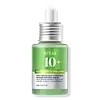What's inside
What's inside
 Key Ingredients
Key Ingredients

 Benefits
Benefits

 Concerns
Concerns

 Ingredients Side-by-side
Ingredients Side-by-side

Water
Skin ConditioningGlycerin
HumectantDipropylene Glycol
HumectantButylene Glycol
Humectant1,2-Hexanediol
Skin ConditioningSalicylic Acid
MaskingPolyacrylate Crosspolymer-6
Emulsion StabilisingTromethamine
BufferingMelia Azadirachta Leaf Extract
Skin ConditioningBetaine
HumectantPolyglyceryl-10 Laurate
Skin ConditioningCarbomer
Emulsion StabilisingHydrogenated Lecithin
EmulsifyingCitric Acid
BufferingCamellia Sinensis Leaf Extract
AntimicrobialEthylhexylglycerin
Skin ConditioningSodium Citrate
BufferingXanthan Gum
EmulsifyingMelia Azadirachta Flower Extract
Skin ConditioningDextrin
AbsorbentTheobroma Cacao Extract
Skin ConditioningTripeptide-1
Skin ConditioningCopper Tripeptide-1
Skin ConditioningAcetyl Tetrapeptide-5
HumectantAcetyl Tetrapeptide-2
Skin ConditioningPalmitoyl Pentapeptide-4
Skin ConditioningPalmitoyl Tripeptide-1
Skin ConditioningHexapeptide-9
Skin ConditioningHexapeptide-11
Skin ConditioningPalmitoyl Tripeptide-5
Skin ConditioningDisodium EDTA
Parfum
MaskingWater, Glycerin, Dipropylene Glycol, Butylene Glycol, 1,2-Hexanediol, Salicylic Acid, Polyacrylate Crosspolymer-6, Tromethamine, Melia Azadirachta Leaf Extract, Betaine, Polyglyceryl-10 Laurate, Carbomer, Hydrogenated Lecithin, Citric Acid, Camellia Sinensis Leaf Extract, Ethylhexylglycerin, Sodium Citrate, Xanthan Gum, Melia Azadirachta Flower Extract, Dextrin, Theobroma Cacao Extract, Tripeptide-1, Copper Tripeptide-1, Acetyl Tetrapeptide-5, Acetyl Tetrapeptide-2, Palmitoyl Pentapeptide-4, Palmitoyl Tripeptide-1, Hexapeptide-9, Hexapeptide-11, Palmitoyl Tripeptide-5, Disodium EDTA, Parfum
Water
Skin ConditioningAzelaic Acid
BufferingPropylene Glycol
HumectantSodium Hydroxide
BufferingDipropylene Glycol
Humectant1,2-Hexanediol
Skin ConditioningPanthenol
Skin ConditioningHydroxyethylcellulose
Emulsion StabilisingBetaine Salicylate
AntimicrobialGlycerin
HumectantBiosaccharide Gum-1
HumectantEthylhexylglycerin
Skin ConditioningAllantoin
Skin ConditioningDipotassium Glycyrrhizate
HumectantMelia Azadirachta Leaf Extract
Skin ConditioningCamellia Sinensis Leaf Water
MaskingSodium Hyaluronate
HumectantMelia Azadirachta Flower Extract
Skin ConditioningNiacinamide
SmoothingAloe Barbadensis Leaf Juice
Skin ConditioningBeta-Glucan
Skin ConditioningCentella Asiatica Extract
CleansingCentella Asiatica Leaf Extract
Skin ConditioningCentella Asiatica Root Extract
Skin ConditioningMadecassoside
AntioxidantAsiaticoside
AntioxidantAsiatic Acid
Skin ConditioningMadecassic Acid
Skin ConditioningSqualane
EmollientZinc PCA
HumectantButylene Glycol
HumectantPentylene Glycol
Skin ConditioningCaprylyl/Capryl Glucoside
CleansingHydrogenated Lecithin
EmulsifyingCeramide NP
Skin ConditioningWater, Azelaic Acid, Propylene Glycol, Sodium Hydroxide, Dipropylene Glycol, 1,2-Hexanediol, Panthenol, Hydroxyethylcellulose, Betaine Salicylate, Glycerin, Biosaccharide Gum-1, Ethylhexylglycerin, Allantoin, Dipotassium Glycyrrhizate, Melia Azadirachta Leaf Extract, Camellia Sinensis Leaf Water, Sodium Hyaluronate, Melia Azadirachta Flower Extract, Niacinamide, Aloe Barbadensis Leaf Juice, Beta-Glucan, Centella Asiatica Extract, Centella Asiatica Leaf Extract, Centella Asiatica Root Extract, Madecassoside, Asiaticoside, Asiatic Acid, Madecassic Acid, Squalane, Zinc PCA, Butylene Glycol, Pentylene Glycol, Caprylyl/Capryl Glucoside, Hydrogenated Lecithin, Ceramide NP
 Reviews
Reviews

Ingredients Explained
These ingredients are found in both products.
Ingredients higher up in an ingredient list are typically present in a larger amount.
1,2-Hexanediol is a synthetic liquid and another multi-functional powerhouse.
It is a:
- Humectant, drawing moisture into the skin
- Emollient, helping to soften skin
- Solvent, dispersing and stabilizing formulas
- Preservative booster, enhancing the antimicrobial activity of other preservatives
Butylene Glycol (or BG) is used within cosmetic products for a few different reasons:
Overall, Butylene Glycol is a safe and well-rounded ingredient that works well with other ingredients.
Though this ingredient works well with most skin types, some people with sensitive skin may experience a reaction such as allergic rashes, closed comedones, or itchiness.
Learn more about Butylene GlycolDipropylene Glycol is a synthetically created humectant, stabilizer, and solvent.
This ingredient helps:
Dipropylene glycol is technically an alcohol, but it belongs to the glycol family (often considered part of the ‘good’ alcohols). This means it is hydrating and gentle on skin unlike drying solvent alcohols like denatured alcohol.
As a masking agent, Dipropylene Glycol can be used to cover the smell of other ingredients. However, it does not have a scent.
Studies show Dipropylene Glycol is considered safe to use in skincare.
Learn more about Dipropylene GlycolEthylhexylglycerin (we can't pronounce this either) is commonly used as a preservative and skin softener. It is derived from glyceryl.
You might see Ethylhexylglycerin often paired with other preservatives such as phenoxyethanol. Ethylhexylglycerin has been found to increase the effectiveness of these other preservatives.
Glycerin is already naturally found in your skin. It helps moisturize and protect your skin.
A study from 2016 found glycerin to be more effective as a humectant than AHAs and hyaluronic acid.
As a humectant, it helps the skin stay hydrated by pulling moisture to your skin. The low molecular weight of glycerin allows it to pull moisture into the deeper layers of your skin.
Hydrated skin improves your skin barrier; Your skin barrier helps protect against irritants and bacteria.
Glycerin has also been found to have antimicrobial and antiviral properties. Due to these properties, glycerin is often used in wound and burn treatments.
In cosmetics, glycerin is usually derived from plants such as soybean or palm. However, it can also be sourced from animals, such as tallow or animal fat.
This ingredient is organic, colorless, odorless, and non-toxic.
Glycerin is the name for this ingredient in American English. British English uses Glycerol/Glycerine.
Learn more about GlycerinHydrogenated Lecithin is created from the hydrogenation of lecithin (a group of phospholipids). Hydrogenation is a chemical reaction between hydrogen and another element.
This ingredient is an emollient and emulsifier. As an emollient, it helps soften skin by trapping moisture within. As an emulsifier, it prevents oil and water ingredients from separating.
Melia Azadirachta Flower Extract is from the Neem tree. Neem trees originate from India.
Melia Azadirachta Flower Extract contains antioxidants. Antioxidants help fight free-radicals. Free-radicals are molecules that may damage your skin cells, such as pollution.
The flowers of this tree are lilac colored.
Learn more about Melia Azadirachta Flower ExtractMelia Azadirachta Leaf Extract is extract from the neem plant.
The leaves of this tree contain flavonoids and polyphenols. These two compounds are antioxidants, anti-inflammatory, and antibacterial. Further research is needed as to their effects when applied on skin.
Water. It's the most common cosmetic ingredient of all. You'll usually see it at the top of ingredient lists, meaning that it makes up the largest part of the product.
So why is it so popular? Water most often acts as a solvent - this means that it helps dissolve other ingredients into the formulation.
You'll also recognize water as that liquid we all need to stay alive. If you see this, drink a glass of water. Stay hydrated!
Learn more about Water